Cobalt Q-6 Slope Rangefinder Review
Our verdict on the Cobalt Q-6 Slope rangefinder, which ranks as one of the most impressive devices in its category
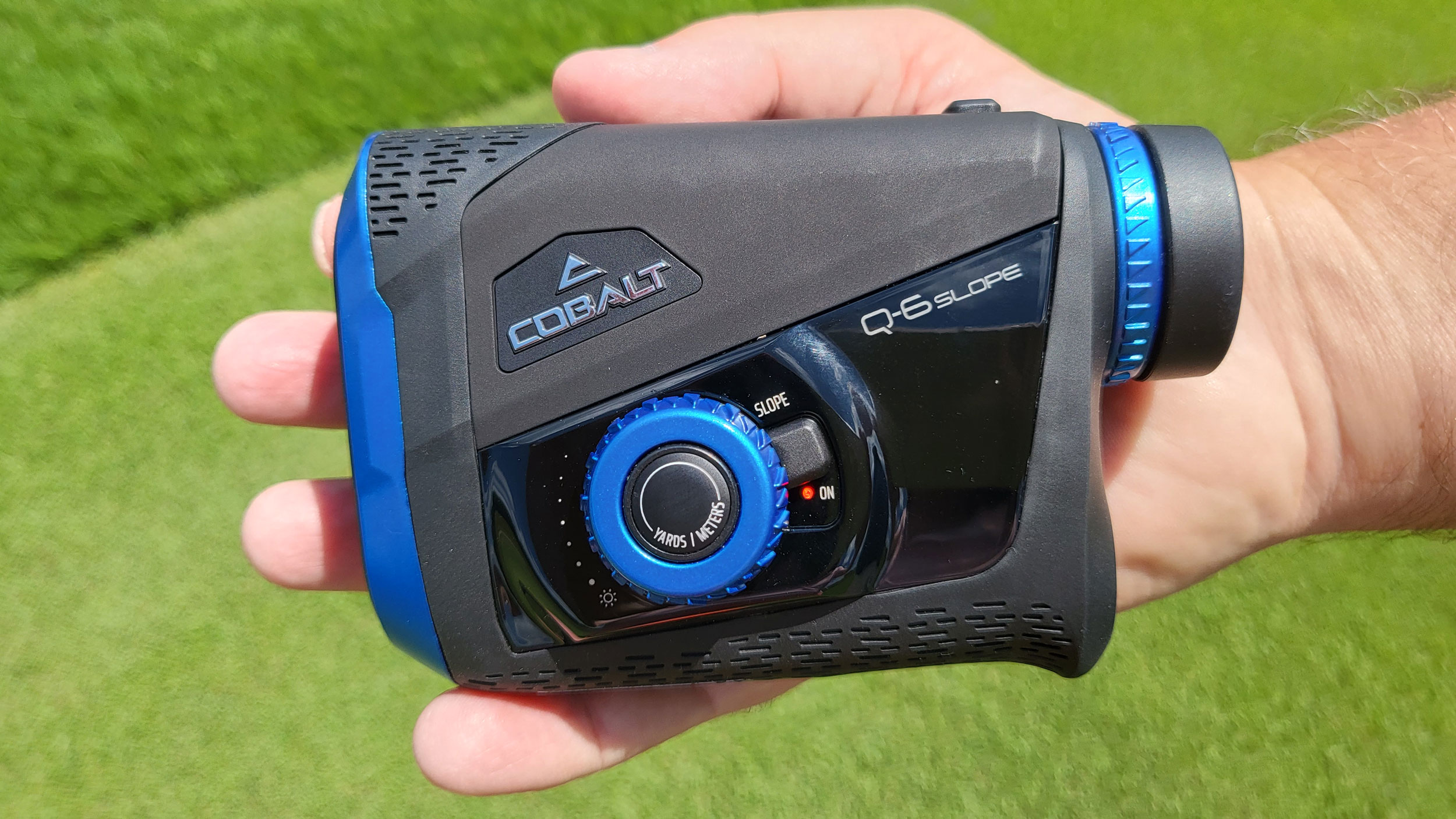
Cobalt Golf has knocked it out of the park with the Q-6 Slope rangefinder, which lives up to lofty promises from the company by offering incredible speed and accuracy and stunningly impressive optics in a device that oozes style and quality craftsmanship. The Q-6 Slope is not only one of the best rangefinders on the market, it’s one of the best products available across any golf category.
-
+
Exceptionally fast and accurate
-
+
Crystal clear, vibrant display optics
-
+
Premium look and feel
-
+
Elite “scan” mode functionality
-
+
Fully waterproof
-
-
Adjusted and actual yardages can’t be displayed together
Why you can trust Golf Monthly
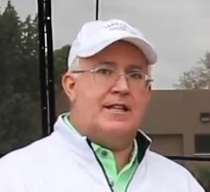
Cobalt Q-6 Slope Rangefinder Review
I’ve said it before and I’ll say it again; if you’re playing golf without a quality laser rangefinder, you’re leaving shots out on the course. Fortunately for golfers, the number of impressive options in the category continues to grow with each passing year, so there’s really no excuse to make the game harder than it needs to be. One of the more impressive rangefinder options to hit the market recently comes from Cobalt Golf, which is an emerging brand with a storied history.
The technology team behind Cobalt Golf’s newest rangefinders has been creating laser devices for more than 25 years, starting with collaborations with NASA as Laser Technology Inc. before moving into golf, where its rangefinders were widely used by PGA Tour players in the early 2000s. The most advanced product available from Cobalt is the Q-6 Slope, which I recently had the chance to test and now ranks as one of the best golf products in any category that I’ve tested this year.
My first impression of the Cobalt Q-6 Slope when taking it out of the box was that the black and blue color combination was visually sharp and that the device felt incredibly sturdy. While many newer rangefinders are going for a more lightweight, compact design, the Q-6 Slope was anything but. In fact, it checks in at just over 300 grams from a weight standpoint, a result of high-end construction rather than unnecessary bulk.
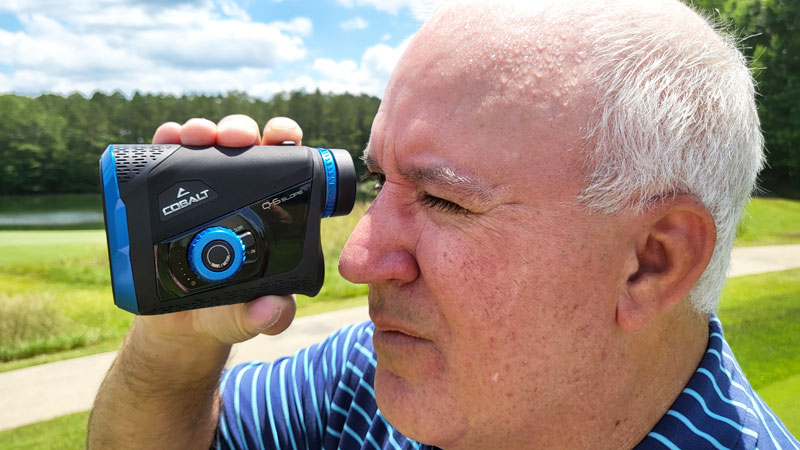
More specifically, the Q-6 slope was constructed using a magnesium chassis that is housed in waterproof aluminum. The device is fully waterproof (IPX7) and Cobalt also offers what for this category is an extremely rare lifetime warranty and will repair or replace at no cost to the consumer any rangefinder that through normal use ever becomes defective or damaged.
- Buy the Cobalt Q-6 Slope rangefinder for $450
With first impressions in the book, it was time to test the Q-6 Slope on the golf course, which was done at Atlanta National over the course of a dedicated testing day and a couple of 18-hole rounds. On the testing day, I compared the Q-6 Slope to a Bushnell V4 Shift in terms of accuracy and performance on the course using marked sprinkler heads and at the driving range using measured targets that are available.
As impressive as the Q-6 Slope’s performance was, which I’ll get into shortly, I’d be remiss to not start with the device’s display optics. The combination of the 7x magnification and crystal clear projection display were impressive enough, but when adding in the fire red digital numbers that are populated after acquiring a target the result was a vibrant, pleasing optical experience that visually exceeded what any other rangefinder I’ve ever tested had to offer.
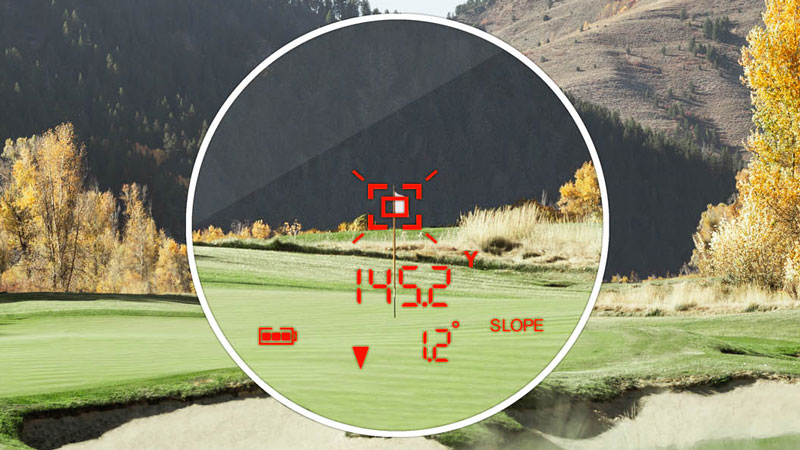
A look at what golfers can expect visually from the Cobalt Q-6 Slope's impressive display optics.
Optics aside, the Q-6 Slope was equally impressive in terms of performance, and my expectations were high based on what Cobalt promised from this device, which included a flag range of 600 yards and target acquisition time of 1/4 of a second. Bold claims to be sure, but the Q-6 Slope delivered. It was incredibly fast at capturing yardages, a process bolstered by a vibration surge upon locking on the target, and it proved to be impressively accurate even from significant ranges in all of the testing I conducted.
The Q-6 Slope also features a scan mode that allows golfers to acquire multiple yardages by holding down the power button and moving from one target to another. This type of technology is readily available in other laser rangefinders as well, but I’ve never tested one that was as effective in that regard as the Q-6 Slope.
While the Q-6 Slope marveled from a technology standpoint, it also offered an understated simplicity in terms of its use. One of its greatest features is what Cobalt calls SmartSwitch, which effectively is the knob-like structure that is prominently positioned on the side of the device.
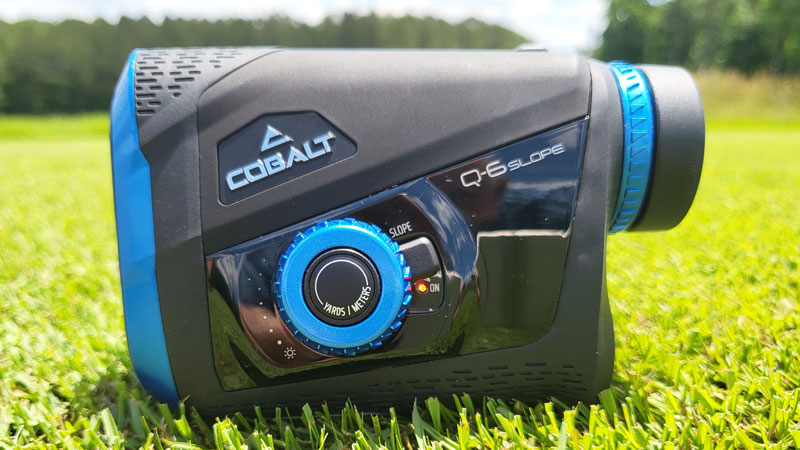
The SmartSwitch feature located on the side of the Q-6 Slope allows golfers to turn slope off and on, switch back and forth between yards and meters, and adjust display brightness.
In that location, players will find a switch to turn slope functionality on or off as needed, a must for using the Q-6 Slope in tournament play. There’s also a red light that illuminates as a reminder that slope is on when the device is in use. Additionally, there’s a dial that can be used to adjust the brightness of the display depending on the lighting conditions you’re playing in, which is a tremendous feature, and there’s also a button that can be used to switch between yards and meters.
If there’s one thing about the Q-6 Slope that some might find to be an issue it’s that actual and adjusted yardages cannot be displayed at the same time. In slope mode, the device only shows the adjusted yardage and degree of slope being measured. This wasn’t an issue for me, as the slope switch can easily be moved while looking through the lens to get both numbers without having to “shoot” twice, and I imagine others will find such a setup to be less complicated. But for some, not having access to both readings at the same time could be a deterrent and therefore worth mentioning.
The Cobalt Q-6 Slope retails for $450, which is on the higher side in the laser rangefinder category but also highly competitive for a device of this caliber. Based on my experience, the Q-6 Slope would be worth every penny and a great investment for any golfer as a long-term solution to his or her measuring device needs. It’s not only one of the best laser rangefinders and best slope rangefinders I’ve ever used, it’s one of the best golf products I’ve tested in recent memory.
Get the Golf Monthly Newsletter
Subscribe to the Golf Monthly newsletter to stay up to date with all the latest tour news, equipment news, reviews, head-to-heads and buyer’s guides from our team of experienced experts.

Chris joined Golf Monthly in February of 2022, becoming the organization’s first full-time staff writer in the United States. In his role at Golf Monthly, Chris reviews a broad spectrum of golf equipment, ranging from the latest in golf clubs to what’s new in the world of golf technology. His vast experience in the game allows him to look beyond the marketing hype to judge the merits of the latest equipment for golfers of all ability levels. As for the trend in golf equipment that Chris has been most impressed with in recent years, the Players Distance Iron category would earn that distinction, as golfers now have far better options for irons that provide the assistance that so many need in terms of distance and forgiveness without forcing them to sacrifice look and feel.
On a personal level, Chris played college golf and was a three-year letterwinner and two-year captain at Lynchburg College in Virginia and later spent two years as the assistant golf coach at the University of Virginia. The vast majority of his professional career, however, has been spent as a sports writer and editor. In the early phases of his career, he covered college football, college basketball, and golf for different newspapers and websites before turning his attention solely to golf in 2011. Over the course of the past decade, Chris managed the Instruction Blog for GolfChannel.com and more recently created equipment-related content for TGW.com and 2ndSwing.com.
An avid player, Chris currently maintains a handicap index of 2.4 and has a career-low round of 66, which he has shot on three occasions. He lives about 20 miles north of Atlanta in Roswell, Georgia, with his wife, Stacey, and is a member at Atlanta National Golf Club.
Chris is currently playing:
Driver: Callaway Epic Sub Zero, 10.5*
Fairway wood: TaylorMade M3, 17*
Hybrid: Callaway Apex UW, 19*
Irons: Mizuno JPX 921 Forged, 4-PW
Gap wedge: Cleveland RTX 4, 50*
Sand wedge: Titleist Vokey SM6, 56M
Lob wedge: Titleist Vokey SM8, 60L
Putter: SeeMore Nashville Z3C
Ball: TaylorMade TP5x
-
 Rory McIlroy Wins The Masters In Playoff To Complete Career Grand Slam
Rory McIlroy Wins The Masters In Playoff To Complete Career Grand SlamThe Northern Irishman battled past Ryder Cup teammate, Justin Rose to finally seal his first Masters title and become the sixth man to win all four men's Majors
By Jonny Leighfield Published
-
 Did You Know The Masters Leaderboard Was Inspired By Fenway Park?
Did You Know The Masters Leaderboard Was Inspired By Fenway Park?The Masters leaderboards are an iconic and historic part of the Augusta National Major, but did you know about its origins and how it operates today?
By Matt Cradock Published
-
 Why The 16th Pin Has Been Moved From Its Traditional Spot For The Masters Final Round
Why The 16th Pin Has Been Moved From Its Traditional Spot For The Masters Final RoundThe 16th pin at Augusta National is in an different position that normal for the final round of The Masters, but why is that?
By Mike Hall Published